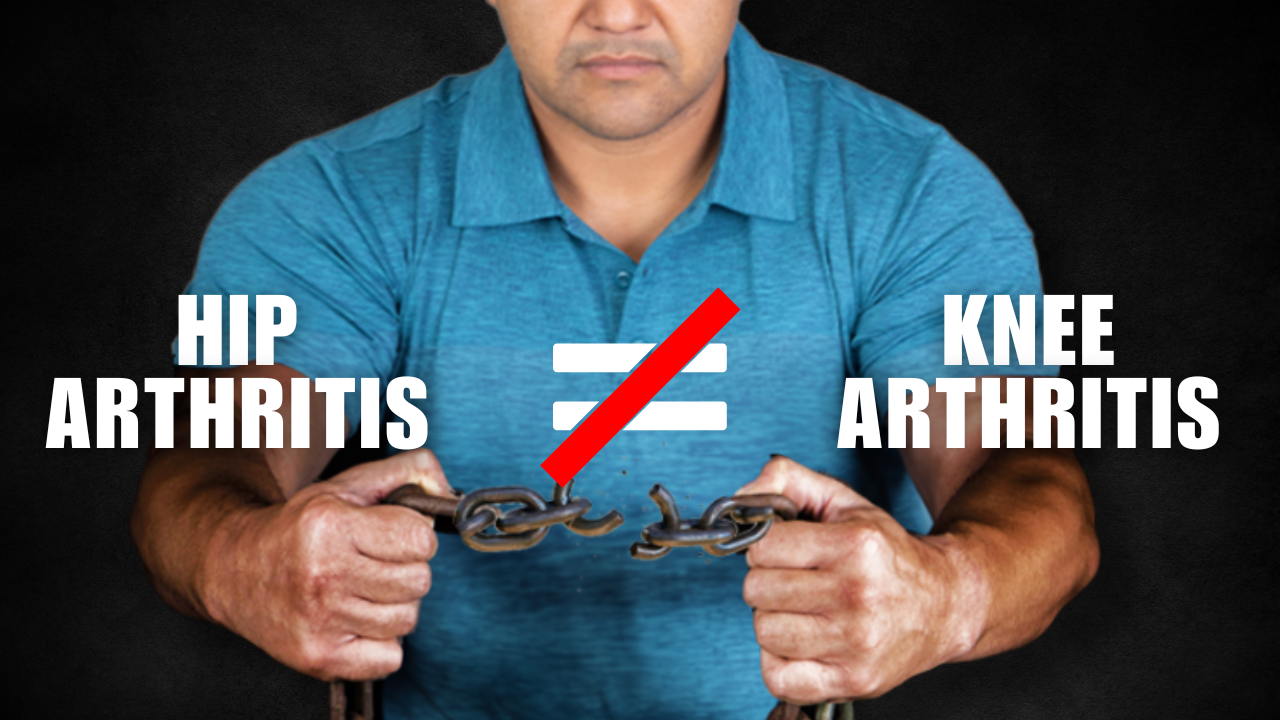Does Hip Osteoarthritis Cause Knee Osteoarthritis? Separating Myths from Facts
Many people believe that if you have arthritis in one joint—such as the hip—you’re destined to develop it in another, like the knee. This is a common assumption made by both patients and healthcare providers. However, this isn’t accurate. In this post, we’ll dive into the connection (or lack thereof) between hip and knee osteoarthritis and what the true root cause of these joint problems may be.
The Myth: One Joint Causes Arthritis in Another
Healthcare professionals often say, “You have hip arthritis? It’s just a matter of time before knee arthritis shows up.” Or vice versa, suggesting that knee arthritis will inevitably lead to hip arthritis. But here’s the truth: **hip arthritis does not cause knee arthritis**, and knee arthritis doesn’t trigger hip arthritis either.
So why do both conditions often appear together? It all comes down to muscle imbalances.
The Root Cause: Muscle Imbalances
The underlying cause of both hip and knee arthritis isn’t one joint “wearing out” the other—it’s a muscle imbalance, particularly between the **quadriceps (front thigh muscles)** and the **glutes (muscles at the back of the hip).**
When the glutes are weak, the body compensates by overusing the quadriceps. This imbalance affects how the **femur (thigh bone)** moves, disrupting the ball-and-socket mechanics in the hip. Since the femur connects the hip and knee, instability or improper movement at the hip joint inevitably alters the forces going through the knee joint.
In other words, **it’s not a direct cause-and-effect relationship between joints**, but the imbalanced way muscles move and stabilize them that leads to arthritis in both places. This imbalance impacts the whole system—both the hip and the knee experience increased, uneven pressures.
Correlation Doesn’t Mean Causation
A critical distinction that many healthcare providers miss is between correlation and causation. Just because people with hip arthritis often develop knee arthritis doesn’t mean one causes the other. Correlation simply means that two things tend to happen together; it doesn’t prove that one triggers the other.
This confusion between correlation and causation leads to oversimplified treatment plans. Some providers may recommend a hip replacement to “save the knee” or vice versa. But this approach overlooks the real problem: imbalanced muscles putting uneven stress on both joints.
Why the Standard Approach Falls Short
Many surgeons and healthcare providers, while skilled and well-meaning, focus heavily on what they know—surgery. If you only look at arthritis through the lens of joint replacements, you might miss the opportunity to address **muscle imbalances** that could improve joint function and reduce pain without surgery.
It’s important to understand that strong muscles stabilize joints and distribute pressure evenly. If your hips, knees, and feet have the right balance of strength, they can function smoothly, even if arthritis is present. Replacing joints without fixing the underlying muscle imbalances is like patching a leaking roof without addressing the cause of the leak—it’s a temporary fix.
Common Myths: Age, Weight, and Genetics
– Age: While arthritis becomes more common with age, it isn’t a guarantee. Many older adults never develop arthritis because they maintain proper muscle function.
– Weight: People with more body weight do tend to have more arthritis, but this isn’t purely due to the extra load. **Being sedentary** and not strengthening key muscles can worsen the imbalance.
– Genetics: Genetics can influence the shape of your joints or predispose you to conditions like bow-leggedness or knock-knees, which may alter joint pressures. However, genetics alone doesn’t mean you’re destined to develop arthritis—lifestyle and muscle health still matter.
Prevention and Treatment: Fix the Muscle Imbalances
To prevent or manage arthritis, focus on correcting muscle imbalances. Here’s what you can do:
1. Strengthen Your Glutes: Strong glute muscles improve hip stability and reduce stress on the knee joint.
2. Work on Foot Strength: Healthy feet also play a role in knee stability by ensuring proper alignment and movement patterns.
3. Maintain Joint Mobility: Ensure your hips and knees can move fully through their natural range of motion. If you can bend and straighten your joints properly, you may just need to improve muscle function, not resort to surgery.
4. Reduce Excessive Pressures: Joints are designed to take pressure, but when muscles are imbalanced, they create harmful forces. Fixing these imbalances ensures that the right kind of pressure is applied.
The Takeaway: You’re Not Destined for Arthritis
Just because arthritis runs in your family or you’ve reached a certain age doesn’t mean your fate is sealed. By maintaining **balanced muscles and healthy movement patterns**, you can preserve the function of your hips and knees for years to come.
If you’ve been told that your hip arthritis will inevitably lead to knee arthritis (or the other way around), remember: It’s not the joints causing each other’s problems—it’s the underlying muscle imbalances. Fix those, and you’ll be on the path to healthier joints without unnecessary surgeries.



